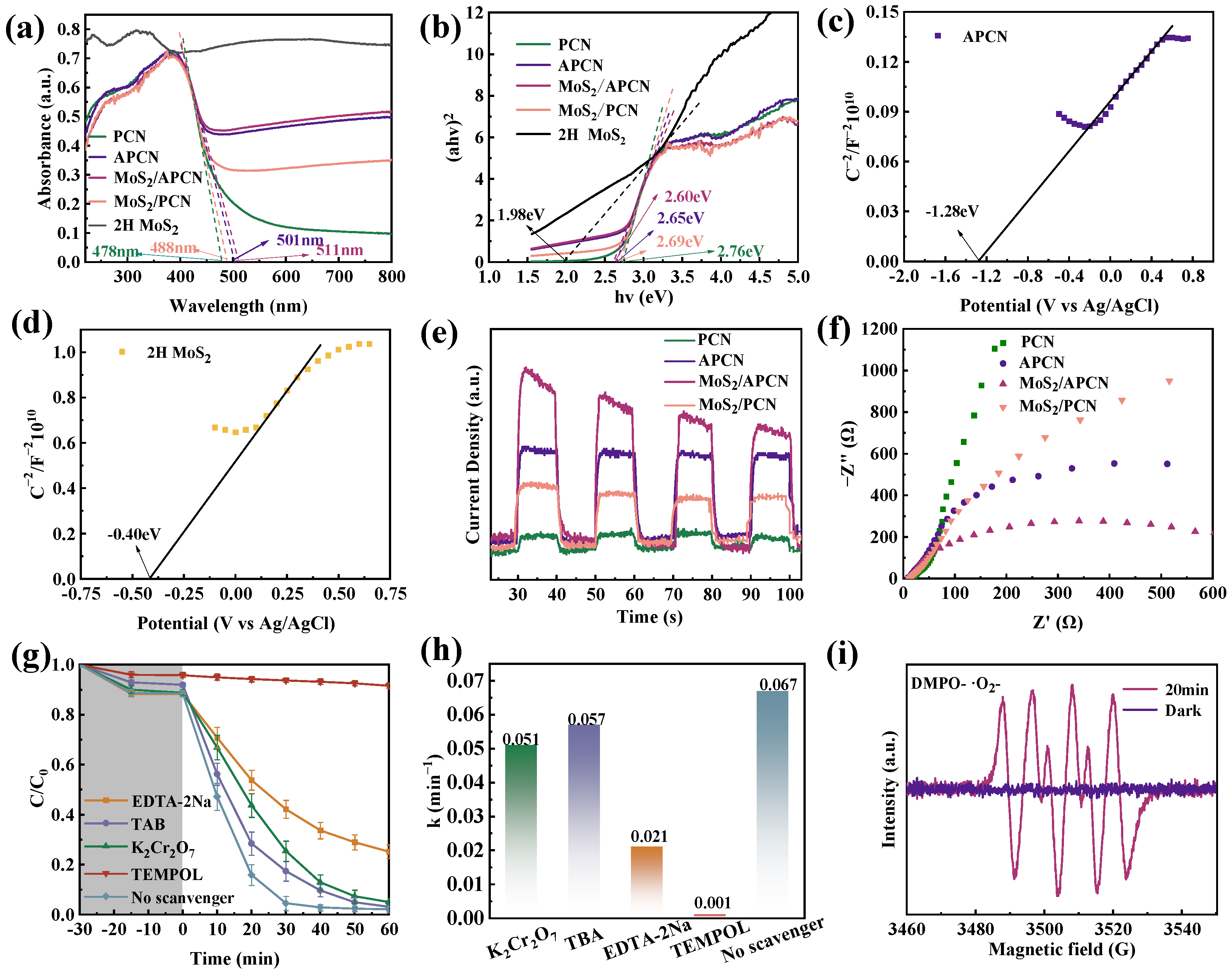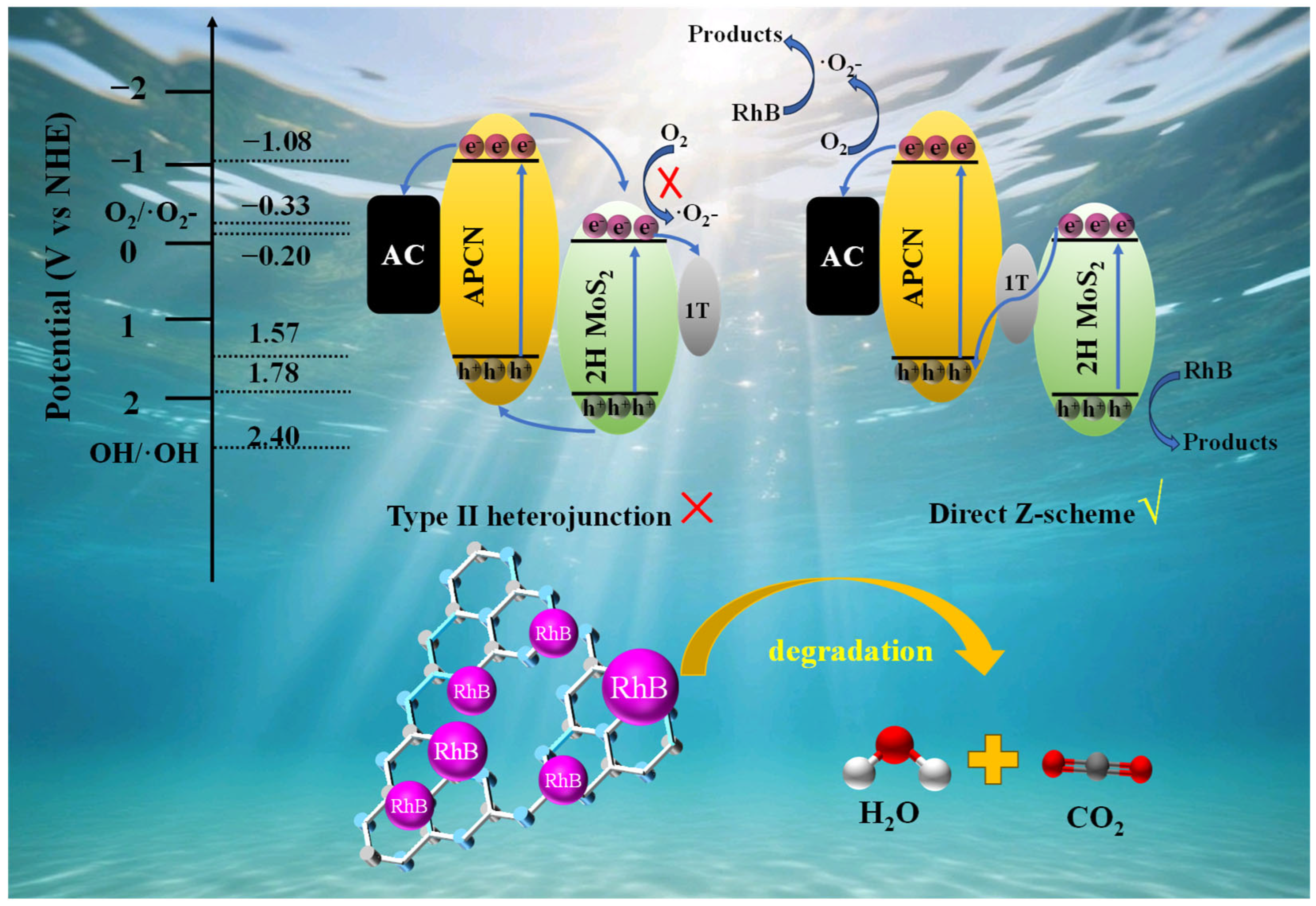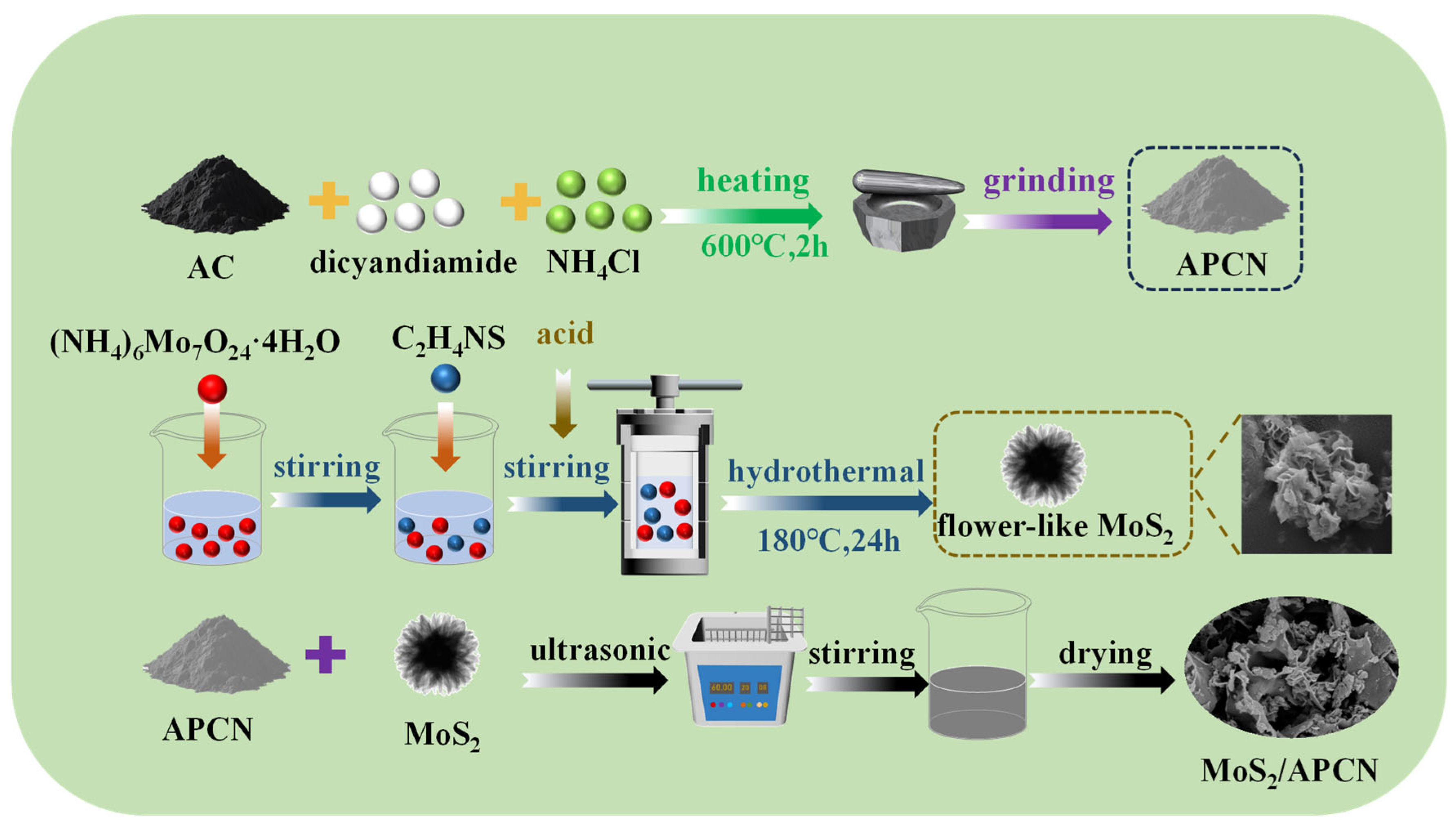Activated Carbon-Modified Porous Carbon Nitride Decorated with Molybdenum Disulfide for Enhanced Photocatalytic Degradation of Rhodamine B
Abstract
1. Introduction
2. Result and Discussion
2.1. Characterization of the Photocatalysts
2.2. Photodegradation Studies of Catalysts
2.3. Photocatalytic Mechanism Research
3. Materials and Methods
3.1. Materials
3.2. Synthesis of AC
3.3. Synthesis of APCN, MoS2, and MoS2/APCN
3.4. Material Characterization
3.5. Photocatalytic Measurements
3.6. Photoelectrochemical Characterization
4. Conclusions
Supplementary Materials
Author Contributions
Funding
Data Availability Statement
Acknowledgments
Conflicts of Interest
References
- Al-Gheethi, A.A.; Azhar, Q.M.; Kumar, P.S.; Yusuf, A.A.; Al-Buriahi, A.K.; Mohamed, R.; Al-shaibani, M.M. Sustainable approaches for removing Rhodamine B dye using agricultural waste adsorbents: A review. Chemosphere 2022, 287, 132080. [Google Scholar] [CrossRef]
- Guo, T.; Fan, X.; Jiang, X.; Qi, Y.; Du, J.; Zhang, A.; Wang, H. Engineering shape of BiOCl nanosheets with improved visible-light response for superior photocatalytic degradation of Rhodamine B. J. Alloys Compd. 2023, 948, 169586. [Google Scholar] [CrossRef]
- Wang, S.; Zhang, J.; Li, B.; Sun, H.; Wang, S. Engineered Graphitic Carbon Nitride-Based Photocatalysts for Visible-Light-Driven Water Splitting: A Review. Energy Fuels 2021, 35, 6504–6526. [Google Scholar] [CrossRef]
- Ma, D.; Zhang, Z.; Zou, Y.; Chen, J.; Shi, J.-W. The progress of g-C3N4 in photocatalytic H2 evolution: From fabrication to modification. Coord. Chem. Rev. 2024, 500, 215489. [Google Scholar] [CrossRef]
- Fu, J.; Yu, J.; Jiang, C.; Cheng, B. g-C3N4-Based Heterostructured Photocatalysts. Adv. Energy Mater. 2017, 8, 1701503. [Google Scholar] [CrossRef]
- Cheng, X.; Cheng, Z.; Jing, B.; Ao, Z.; Shang, C.; Ling, L. Visible light-driven NH2Cl activation by g-C3N4 photocatalysis producing reactive nitrogen species to degrade bisphenol A. Water Res. 2023, 235, 119889. [Google Scholar] [CrossRef]
- Karthik, P.; Gowthaman, P.; Venkatachalam, M.; Saroja, M. Design and fabrication of g-C3N4 nanosheets decorated TiO2 hybrid sensor films for improved performance towards CO2 gas. Inorg. Chem. Commun. 2020, 119, 108060. [Google Scholar] [CrossRef]
- Arumugam, M.; Tahir, M.; Praserthdam, P. Effect of nonmetals (B, O, P, and S) doped with porous g-C3N4 for improved electron transfer towards photocatalytic CO2 reduction with water into CH4. Chemosphere 2022, 286 Pt 2, 131765. [Google Scholar] [CrossRef]
- Liu, Z.; Yang, Y.; Guo, Z.; Kong, L.; Song, P. g-C3N4/MnFe2O4 p-n hollow stratified heterojunction to improve the photocatalytic CO2 reduction activity. Chem. Phys. Lett. 2023, 827, 140698. [Google Scholar] [CrossRef]
- Fei, B.; Tang, Y.; Wang, X.; Dong, X.; Liang, J.; Fei, X.; Xu, L.; Song, Y.; Zhang, F. One-pot synthesis of porous g-C3N4 nanomaterials with different morphologies and their superior photocatalytic performance. Mater. Res. Bull. 2018, 102, 209–217. [Google Scholar] [CrossRef]
- Azam, K.; Shezad, N.; Shafiq, I.; Akhter, P.; Akhtar, F.; Jamil, F.; Shafique, S.; Park, Y.K.; Hussain, M. A review on activated carbon modifications for the treatment of wastewater containing anionic dyes. Chemosphere 2022, 306, 135566. [Google Scholar] [CrossRef] [PubMed]
- Li, X.; Zeng, J.; Zuo, S.; Lin, S.; Chen, G. Preparation, Modification, and Application of Biochar in the Printing Field: A Review. Materials 2023, 16, 5081. [Google Scholar] [CrossRef] [PubMed]
- Gloria, D.C.S.; Brito, C.H.V.; Mendonça, T.A.P.; Brazil, T.R.; Domingues, R.A.; Vieira, N.C.S.; Santos, E.B.; Gonçalves, M. Preparation of TiO2/activated carbon nanomaterials with enhanced photocatalytic activity in paracetamol degradation. Mater. Chem. Phys. 2023, 305, 127947. [Google Scholar] [CrossRef]
- Rungsawang, T.; Krobthong, S.; Paengpan, K.; Kaewtrakulchai, N.; Manatura, K.; Eiad-Ua, A.; Boonruang, C.; Wongrerkdee, S. Synergy of functionalized activated carbon and ZnO nanoparticles for enhancing photocatalytic degradation of methylene blue and carbaryl. Radiat. Phys. Chem. 2024, 223, 111924. [Google Scholar] [CrossRef]
- Lu, S.; Liu, F.; Qiu, P.; Qiao, M.; Li, Y.; Cheng, Z.; Xue, N.; Hou, X.; Xu, C.; Xiang, Y.; et al. Photothermal-assisted photocatalytic degradation with ultrahigh solar utilization: Towards practical application. Chem. Eng. J. 2020, 379, 122382. [Google Scholar] [CrossRef]
- Shi, J.; Chen, T.; Guo, C.; Liu, Z.; Feng, S.; Li, Y.; Hu, J. The bifunctional composites of AC restrain the stack of g-C3N4 with the excellent adsorption-photocatalytic performance for the removal of RhB. Colloids Surf. A 2019, 580, 123701. [Google Scholar] [CrossRef]
- Sekar, S.; Preethi, V.; Srivishnu, V.S.; Saravanan, S.; Lee, S. Highly-efficient photocatalytic activity of TiO2-AC nanocomposites for hydrogen production from sulphide wastewater. Int. J. Hydrogen Energy 2022, 47, 40275–40285. [Google Scholar] [CrossRef]
- Hua, X.Y.; Chen, H.J.; Rong, C.; Addison, F.; Dong, D.M.; Qu, J.; Liang, D.P.; Guo, Z.Y.; Zheng, N.; Liu, H.Y. Visible-light-driven photocatalytic degradation of tetracycline hydrochloride by Z-scheme Ag3PO4/1T@2H-MoS2 heterojunction: Degradation mechanism toxicity assessment, and potential applications. J. Hazard. Mater. 2023, 448, 130951. [Google Scholar] [CrossRef] [PubMed]
- Xin, X.; Song, Y.; Guo, S.; Zhang, Y.; Wang, B.; Wang, Y.; Li, X. One-step synthesis of P-doped MoS2 for efficient photocatalytic hydrogen production. J. Alloys Compd. 2020, 829, 154635. [Google Scholar] [CrossRef]
- Senthilnathan, S.; Ganesh Kumar, K.; Sugunraj, S.; Dhanalakshmi, M.A.; M, R.; Suganthi, M.; Shree Kesavan, K.; Sasikumar, P.; Abbas, M.; Dator, W.L.T. MoS2 modified g-C3N4 composite: A potential candidate for photocatalytic applications. J. Saudi Chem. Soc. 2023, 27, 101717. [Google Scholar] [CrossRef]
- Asadzadeh-Khaneghah, S.; Habibi-Yangjeh, A. g-C3N4/carbon dot-based nanocomposites serve as efficacious photocatalysts for environmental purification and energy generation: A review. J. Cleaner Prod. 2020, 276, 124319. [Google Scholar] [CrossRef]
- Jiao, Y.; Huang, Q.; Wang, J.; He, Z.; Li, Z. A novel MoS2 quantum dots (QDs) decorated Z-scheme g-C3N4 nanosheet/N-doped carbon dots heterostructure photocatalyst for photocatalytic hydrogen evolution. Appl. Catal. B 2019, 247, 124–132. [Google Scholar] [CrossRef]
- Zhang, Q.; Wang, Y.; Zhu, X.; Liu, X.; Li, H. 1T and 2H mixed phase MoS2 nanobelts coupled with Ti3+ self-doped TiO2 nanosheets for enhanced photocatalytic degradation of RhB under visible light. Appl. Surf. Sci. 2021, 556, 149768. [Google Scholar] [CrossRef]
- Huang, J.; Meng, T.; Yi, F.; Cui, Z.; Shu, D.; Gao, A. NH4+ intercalated 1T/2H hybrid MoS2@AlOOH for long-term aqueous ammonium-ion storage. J. Solid State Chem. 2024, 338, 124837. [Google Scholar] [CrossRef]
- Yang, H.; Cao, R.; Sun, P.; Yin, J.; Zhang, S.; Xu, X. Constructing electrostatic self-assembled 2D/2D ultra-thin ZnIn2S4/protonated g-C3N4 heterojunctions for excellent photocatalytic performance under visible light. Appl. Catal. B 2019, 256, 117862. [Google Scholar] [CrossRef]
- Zheng, Y.; Wei, C.; An, Q.; Yu, J.; Xu, S.; Li, L. The preparation of Al2O3/g-C3N4 composites in aluminum–water self-assembly system and its improved photocatalytic properties. New J. Chem. 2021, 45, 16750–16759. [Google Scholar] [CrossRef]
- Zhu, K.; Luan, X.; Matras-Postolek, K.; Yang, P. 2D/2D MoS2/g-C3N4 layered heterojunctions with enhanced interfacial electron coupling effect. J. Electroanal. Chem. 2021, 893, 115350. [Google Scholar] [CrossRef]
- Buttersack, C. Modeling of type IV and V sigmoidal adsorption isotherms. Phys. Chem. Chem. Phys. 2019, 21, 5614–5626. [Google Scholar] [CrossRef]
- Wang, X.; Liu, X.; Wen, H.; Guo, K.; Brendon, H.; Liu, D. A green, efficient reductive N-formylation of nitro compounds catalyzed by metal-free graphitic carbon nitride supported on activated carbon. Appl. Catal. B 2023, 321, 122042. [Google Scholar] [CrossRef]
- Zeng, X.; Wang, X.; Shu, S.; Zhang, R.; Chen, J.; Wang, Y. Constructing a Z-scheme β-Bi2O3/g-C3N4 heterojunction with enhancing photocatalytic activity for sulfamethoxypyridazine degradation. Mater. Sci. Semicond. Process. 2025, 189, 109273. [Google Scholar] [CrossRef]
- Liu, H.; Liang, J.; Shao, L.; Du, J.; Gao, Q.; Fu, S.; Li, L.; Hu, M.; Zhao, F.; Zhou, J. Promoting charge separation in dual defect mediated Z-scheme MoS2/g-C3N4 photocatalysts for enhanced photocatalytic degradation activity: Synergistic effect insight. Colloids Surf. A 2020, 594, 124668. [Google Scholar] [CrossRef]
- Liang, Z.; Xue, Y.; Guo, Y.; Zhang, G.; Cui, H.; Tian, J. Rationalizing and controlling the phase transformation of semi-metallic 1T′-phase and semi-conductive 2H-phase MoS2 as cocatalysts for photocatalytic hydrogen evolution. Chem. Eng. J. 2020, 396, 125344. [Google Scholar] [CrossRef]
- Zheng, L.; Zhang, R.; Chang, F.; Liu, M.; Deng, J.; Hu, J.; He, J.; Feng, D.; Gao, J.; Chen, C.; et al. Ultrathin 1T/2H mixed phase MoS2 decorated TiO2 nanorod arrays for effective photocatalytic hydrogen evolution. CrystEngComm 2021, 23, 3710–3716. [Google Scholar] [CrossRef]
- Yan, J.; Huang, Y.; Zhang, X.; Gong, X.; Chen, C.; Nie, G.; Liu, X.; Liu, P. MoS2-Decorated/Integrated Carbon Fiber: Phase Engineering Well-Regulated Microwave Absorber. Nanomicro Lett. 2021, 13, 114. [Google Scholar] [CrossRef] [PubMed]
- Liu, X.; Wang, B.; Liu, M.; Liu, S.; Chen, W.; Gao, L.; Li, X. In situ growth of vertically aligned ultrathin MoS2 on porous g-C3N4 for efficient photocatalytic hydrogen production. Appl. Surf. Sci. 2021, 554, 149617. [Google Scholar] [CrossRef]
- Wen, M.Q.; Xiong, T.; Zang, Z.G.; Wei, W.; Tang, X.S.; Dong, F. Synthesis of MoS2/g-C3N4 nanocomposites with enhanced visible-light photocatalytic activity for the removal of nitric oxide (NO). Opt. Express 2016, 24, 10205–10212. [Google Scholar] [CrossRef]
- Sun, C.; Li, F.; Ren, J.; Wu, J.; Wang, G.; Chen, L. Photocatalytic H2 production with simultaneous wastewater purification over flower-like 1T/2H-MoS2-decorated CNT/CNU isotype heterojunction photocatalyst. Appl. Surf. Sci. 2021, 569, 151072. [Google Scholar] [CrossRef]
- Li, S.; Niu, Z.; Pan, D.; Cui, Z.; Shang, H.; Lian, J.; Wu, W. Efficient photoreduction strategy for uranium immobilization based on graphite carbon nitride/activated carbon nanocomposites. Chin. Chem. Lett. 2022, 33, 3581–3584. [Google Scholar] [CrossRef]
- Qin, H.; Guo, R.T.; Liu, X.Y.; Pan, W.G.; Wang, Z.Y.; Shi, X.; Tang, J.Y.; Huang, C.Y. Z-Scheme MoS2/g-C3N4 heterojunction for efficient visible light photocatalytic CO2 reduction. Dalton Trans. 2018, 47, 15155–15163. [Google Scholar] [CrossRef]
- Mehtab, A.; Ali, S.A.; Ingole, P.P.; Mao, Y.; Alshehri, S.M.; Ahmad, T. MoS2 Nanoflower-Deposited g-C3N4 Nanosheet 2D/2D Heterojunction for Efficient Photo/Electrocatalytic Hydrogen Evolution. ACS Appl. Energy Mater. 2023, 6, 12003–12012. [Google Scholar] [CrossRef]
- Zhu, C.; Xian, Q.; He, Q.; Chen, C.; Zou, W.; Sun, C.; Wang, S.; Duan, X. Edge-Rich Bicrystalline 1T/2H-MoS2 Cocatalyst-Decorated 110 Terminated CeO2 Nanorods for Photocatalytic Hydrogen Evolution. ACS Appl. Mater. Interfaces 2021, 13, 35818–35827. [Google Scholar] [CrossRef]
- Han, X.; Liu, Q.; Qian, A.; Ye, L.; Pu, X.; Liu, J.; Jia, X.; Wang, R.; Ju, F.; Sun, H.; et al. Transition-Metal Single Atom Anchored on MoS2 for Enhancing Photocatalytic Hydrogen Production of g-C3N4 Photocatalysts. ACS Appl. Mater. Interfaces 2023, 15, 26670–26681. [Google Scholar] [CrossRef]
- Azhar, A.; Basit, M.A.; Mehmood, W.; Ali, M.A.; Zahid, S.; Ahmad, M.; Zaidi, S.J.A.; Park, T.J. Synchronized wet-chemical development of 2-dimensional MoS2 and g-C3N4/MoS2 QDs nanocomposite as efficient photocatalysts for detoxification of aqueous dye solutions. Colloids Surf. A 2023, 657, 130581. [Google Scholar] [CrossRef]
- Yuan, Y.; Guo, R.T.; Hong, L.F.; Ji, X.Y.; Li, Z.S.; Lin, Z.D.; Pan, W.G. Recent advances and perspectives of MoS2 based materials for photocatalytic dyes degradation: A review. Colloids Surf. A 2021, 611, 125836. [Google Scholar] [CrossRef]
- Yue, Y.; Hou, K.; Chen, J.; Cheng, W.; Wu, Q.; Han, J.; Jiang, J. Ag/AgBr/AgVO3 Photocatalyst-Embedded Polyacrylonitrile/Polyamide/Chitosan Nanofiltration Membrane for Integrated Filtration and Degradation of RhB. ACS Appl. Mater. Interfaces 2022, 14, 24708–24719. [Google Scholar] [CrossRef] [PubMed]
- Shi, W.; Fang, W.X.; Wang, J.C.; Qiao, X.; Wang, B.; Guo, X. pH-controlled mechanism of photocatalytic RhB degradation over g-C3N4 under sunlight irradiation. Photochem. Photobiol. Sci. 2021, 20, 303–313. [Google Scholar] [CrossRef] [PubMed]
- Ćirković, J.; Radojković, A.; Luković Golić, D.; Tasić, N.; Čizmić, M.; Branković, G.; Branković, Z. Visible-light photocatalytic degradation of Mordant Blue 9 by single-phase BiFeO3 nanoparticles. J. Environ. Chem. Eng. 2021, 9, 104587. [Google Scholar] [CrossRef]
- Pan, H.; Gu, J.; Hou, K.; Li, J.; Wang, Y.; Yue, Y. High-efficiency, compressible, and recyclable reduced graphene oxide/chitosan composite aerogels supported g-C3N4/BiOBr photocatalyst for adsorption and degradation of rhodamine B. J. Environ. Chem. Eng. 2022, 10, 107157. [Google Scholar] [CrossRef]
- Li, J.; Wang, Y.; Yue, Y. A Transparent, High-Strength, and Recyclable Core–Shell Structured Wood Hydrogel Integrated with Carbon Dots for Photodegradation of Rhodamine B. ACS Appl. Nano Mater. 2023, 6, 2894–2907. [Google Scholar] [CrossRef]
- Doumbia, M.; Guenfoud, F.; Boudriche, L.; Giannakis, S. UVA-assisted photocatalytic removal of rhodamine B using green-synthesized activated carbon derived from date pits and impregnated with Ag/Ag3PO4. J. Coord. Chem. 2024, 77, 2791–2817. [Google Scholar] [CrossRef]
- Nguyen, H.T.; Doan, V.; Nguyen, T.L.H.; Nguyen, A.T.; Tran, Q.H.; Tran, V.A.; Le, V.T. Mechanistic pathway and optimization of rhodamine B degradation using Mn3O4/ZnO nanocomposite on microalgae-based carbon. RSC Adv. 2025, 15, 6241–6259. [Google Scholar] [CrossRef]
- Bhaysar, K.S.; Labhane, P.K.; Dhake, R.B.; Sonawane, G.H. Crystal structures, morphological, optical, adsorption, kinetic and photocatalytic degradation studies of activated carbon loaded BiOBr nanoplates prepared by solvothermal method. Inorg. Chem. Commun. 2019, 104, 134–144. [Google Scholar] [CrossRef]
- Sumi, K.; Supraja, K.S.; Aashika, R.C.; Arivanandhan, M. Biomass-derived activated carbon/cerium oxide nanocomposite as adsorptive photocatalyst for effective removal of carcinogenic dye. Mater. Res. Bull. 2025, 183, 113212. [Google Scholar] [CrossRef]
- Li, J.; Jiang, Z.X.; Li, J.F.; Li, B.Y.; Wang, X.L.; Shi, Q.W. Synthesis of black titanium dioxide/activated carbon composites for enhanced visible-light photocatalytic properties. J. Mater. Sci.-Mater. Electron. 2024, 35, 1050. [Google Scholar] [CrossRef]
- Mittal, M.; Gupta, A.; Pandey, O.P. Role of oxygen vacancies in Ag/Au doped CeO2 nanoparticles for fast photocatalysis. Sol. Energy 2018, 165, 206–216. [Google Scholar] [CrossRef]
- Mei, X.Q.; Yuan, H.; Li, C.H. Study on the MOF Frame Pt-TiO2 Hybrid Photocatalyst and Its Photocatalytic Performance. Sustainability 2023, 15, 1403. [Google Scholar] [CrossRef]
- Alshammari, A.S.; Bagabas, A.; Alarifi, N.; Altamimi, R. Effect of the Nature of Metal Nanoparticles on the Photocatalytic Degradation of Rhodamine B. Top. Catal. 2019, 62, 786–794. [Google Scholar] [CrossRef]
- Ali, G.; Ahmad, W.; Mullani, N.; Basit, M.A.; Park, T.J. Contrasting photocatalytic performance of quantum-dot sensitized p-type and n-type TiO2 hierarchical nanocomposites under visible light. Mater. Chem. Phys. 2023, 308, 128233. [Google Scholar] [CrossRef]
- Chen, P.F.; Zhang, L.; Wu, Q.; Yao, W.F. Novel synthesis of Ag3PO4/CNFs/silica-fiber hybrid composite as an efficient photocatalyst. J. Taiwan Inst. Chem. Eng. 2016, 63, 506–511. [Google Scholar] [CrossRef]
- Kumar, Y.; Sharma, K.; Sudhaik, A.; Raizada, P.; Thakur, S.; Nguyen, V.; Van Le, Q.; Ahamad, T.; Alshehri, S.M.; Singh, P. Fabrication of magnetically retrievable ZnIn2S4/Bi2O2CO3/ ZnFe2O4 dual S-scheme heterojunction for superior photocatalytic activity. Appl. Nanosci. 2023, 13, 4129–4142. [Google Scholar] [CrossRef]
- Zhu, K.; Luan, X.; Wang, B.; Yang, P. MoS2 (1T/2H)/g-C3N4 heterojunctions created via Mo seed growth in situ towards high photo- and electro-chemical performance. J. Electronal. Chem. 2021, 899, 115683. [Google Scholar] [CrossRef]
- Landi, S.; Segundo, I.R.; Freitas, E.; Vasilevskiy, M.; Carneiro, J.; Tavares, C.J. Use and misuse of the Kubelka-Munk function to obtain the band gap energy from diffuse reflectance measurements. Solid State Commun. 2022, 341, 114573. [Google Scholar] [CrossRef]
- Zhao, W.; Liu, J.; Ding, Z.; Zhang, J.; Wang, X. Optimal synthesis of platinum-free 1D/2D CdS/MoS2 (CM) heterojunctions with improved photocatalytic hydrogen production performance. J. Alloys Compd. 2020, 813, 152234. [Google Scholar] [CrossRef]
- Liu, H.-Y.; Yang, C.-L.; Wang, M.-S.; Ma, X.-G. Two-dimensional hexaphosphate BiMP6 (M = Al, Ga, In) with desirable band gaps and ultrahigh carrier mobility for photocatalytic hydrogen evolution. Appl. Surf. Sci. 2020, 517, 146116. [Google Scholar] [CrossRef]
- Tang, J.; Huang, J.; Ding, D.; Zhang, S.; Deng, X. Research progress of 1T-MoS2 in electrocatalytic hydrogen evolution. Int. J. Hydrogen Energy 2022, 47, 39771–39795. [Google Scholar] [CrossRef]
- Yue, Y.; Shen, S.; Cheng, W.; Han, G.; Wu, Q.; Jiang, J. Construction of mechanically robust and recyclable photocatalytic hydrogel based on nanocellulose-supported CdS/MoS2/Montmorillonite hybrid for antibiotic degradation. Colloids Surf. A 2022, 636, 128035. [Google Scholar] [CrossRef]
- Liang, J.; Ning, X.-A.; Sun, J.; Song, J.; Hong, Y.; Cai, H. An integrated permanganate and ozone process for the treatment of textile dyeing wastewater: Efficiency and mechanism. J. Clean. Prod. 2018, 204, 12–19. [Google Scholar] [CrossRef]
- Vaishali, M.S.; Priyadarshini, N.; Nagapandiselvi, P.; Chandraleka, C. Calcium molybdate/activated carbon nanocomposite: A dual-functional material for energy storage and photocatalytic applications. Colloids Surf. A 2025, 721, 137207. [Google Scholar] [CrossRef]






| Samples | Specifc Surface Area (SBET, m2/g) | Pore Volume (cm3/g) | Average Pore Width (nm) |
|---|---|---|---|
| PCN | 39.12 ± 0.8824 | 0.24 ± 0.01 | 26.02 ± 0.04 |
| APCN | 70.34 ± 1.2853 | 0.43 ± 0.04 | 24.95 ± 0.06 |
| MoS2/APCN | 71.28 ± 1.8933 | 0.40 ± 0.03 | 22.61 ± 0.06 |
| Photocatalyst | k (min–1) | R2 |
|---|---|---|
| PCN | 0.010 ± 0.27 × 10−3 | 0.997 |
| APCN | 0.044 ± 2.23 × 10−3 | 0.986 |
| MoS2/PCN | 0.078 ± 6.34 × 10−3 | 0.984 |
| MoS2/APCN | 0.035 ± 1.12 × 10−3 | 0.982 |
Disclaimer/Publisher’s Note: The statements, opinions and data contained in all publications are solely those of the individual author(s) and contributor(s) and not of MDPI and/or the editor(s). MDPI and/or the editor(s) disclaim responsibility for any injury to people or property resulting from any ideas, methods, instructions or products referred to in the content. |
© 2025 by the authors. Licensee MDPI, Basel, Switzerland. This article is an open access article distributed under the terms and conditions of the Creative Commons Attribution (CC BY) license (https://creativecommons.org/licenses/by/4.0/).
Share and Cite
Li, K.; Wang, D.; Tang, N.; Zhou, Z.; Zhang, W.; Liu, B.; Yue, Y. Activated Carbon-Modified Porous Carbon Nitride Decorated with Molybdenum Disulfide for Enhanced Photocatalytic Degradation of Rhodamine B. Catalysts 2025, 15, 875. https://doi.org/10.3390/catal15090875
Li K, Wang D, Tang N, Zhou Z, Zhang W, Liu B, Yue Y. Activated Carbon-Modified Porous Carbon Nitride Decorated with Molybdenum Disulfide for Enhanced Photocatalytic Degradation of Rhodamine B. Catalysts. 2025; 15(9):875. https://doi.org/10.3390/catal15090875
Chicago/Turabian StyleLi, Kunyang, Di Wang, Ning Tang, Zhou Zhou, Wen Zhang, Bohan Liu, and Yiying Yue. 2025. "Activated Carbon-Modified Porous Carbon Nitride Decorated with Molybdenum Disulfide for Enhanced Photocatalytic Degradation of Rhodamine B" Catalysts 15, no. 9: 875. https://doi.org/10.3390/catal15090875
APA StyleLi, K., Wang, D., Tang, N., Zhou, Z., Zhang, W., Liu, B., & Yue, Y. (2025). Activated Carbon-Modified Porous Carbon Nitride Decorated with Molybdenum Disulfide for Enhanced Photocatalytic Degradation of Rhodamine B. Catalysts, 15(9), 875. https://doi.org/10.3390/catal15090875







